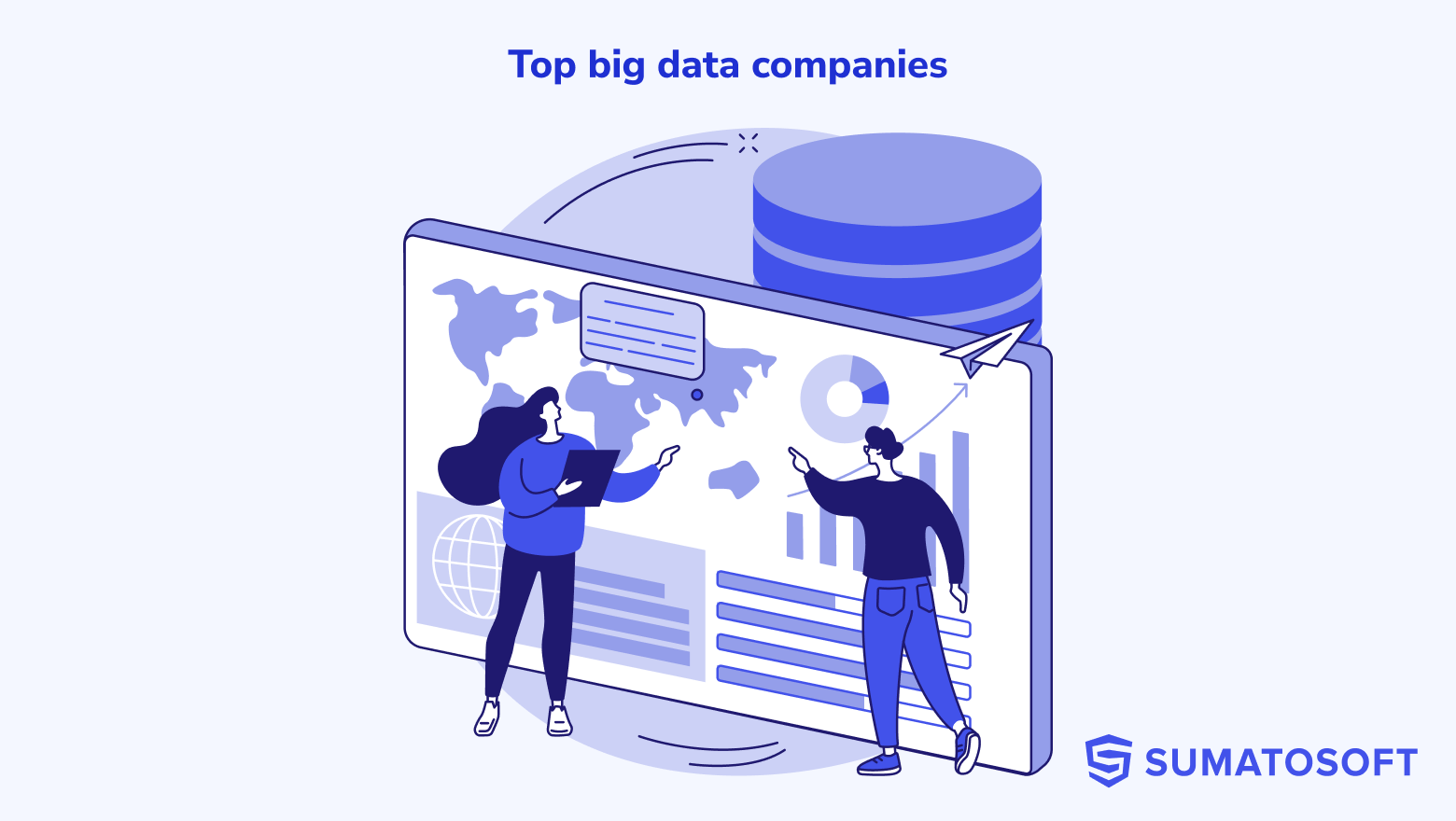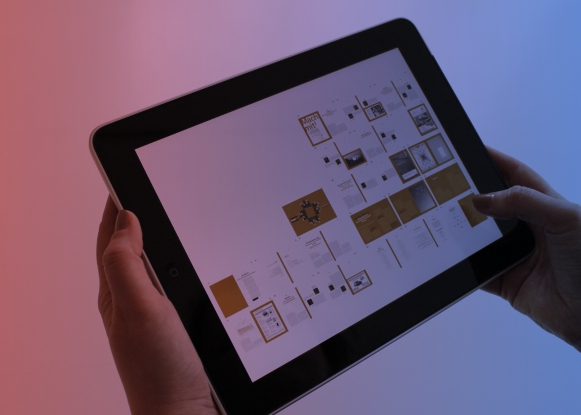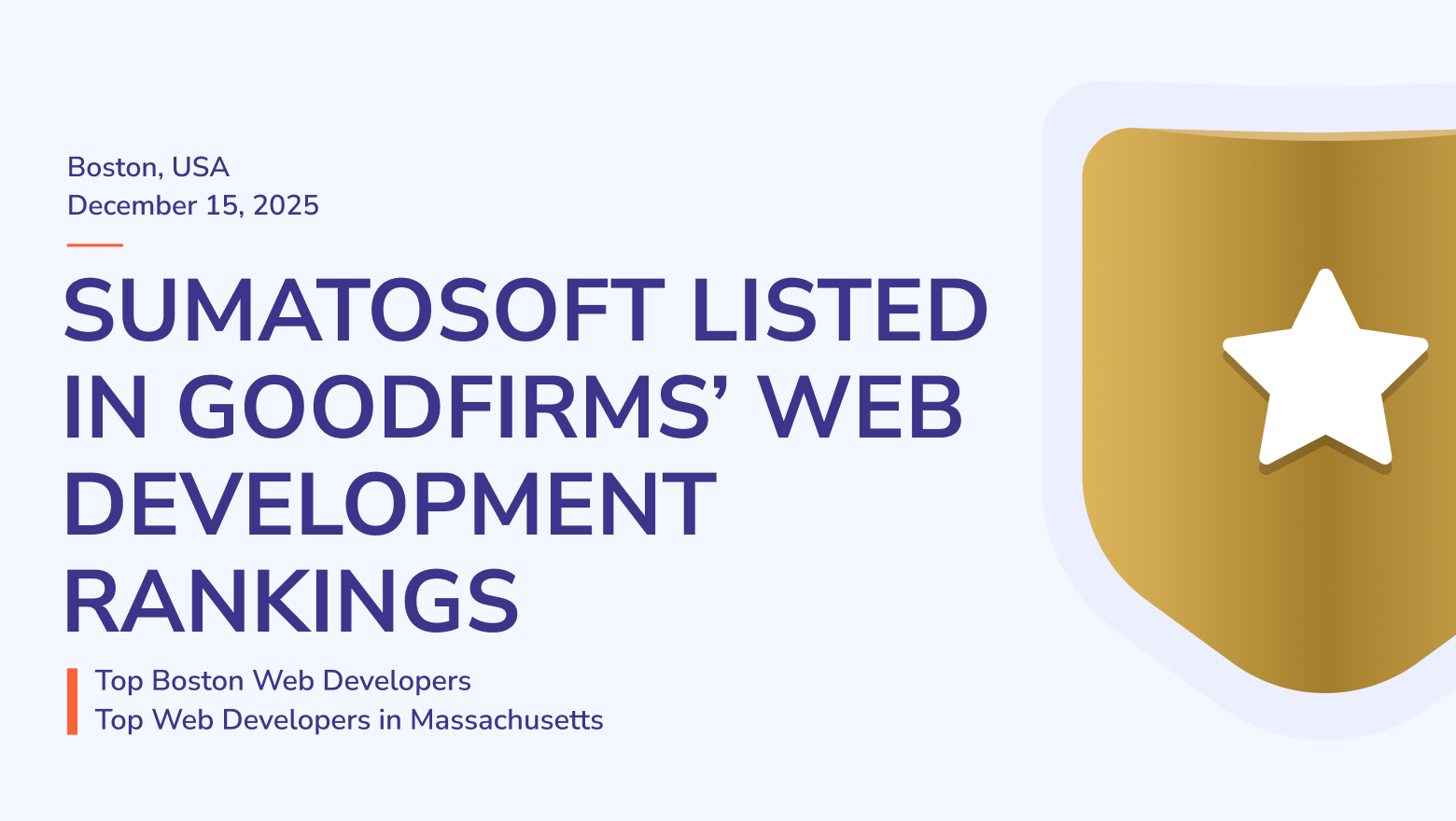Complete Guide: IoT Development Costs Breakdown
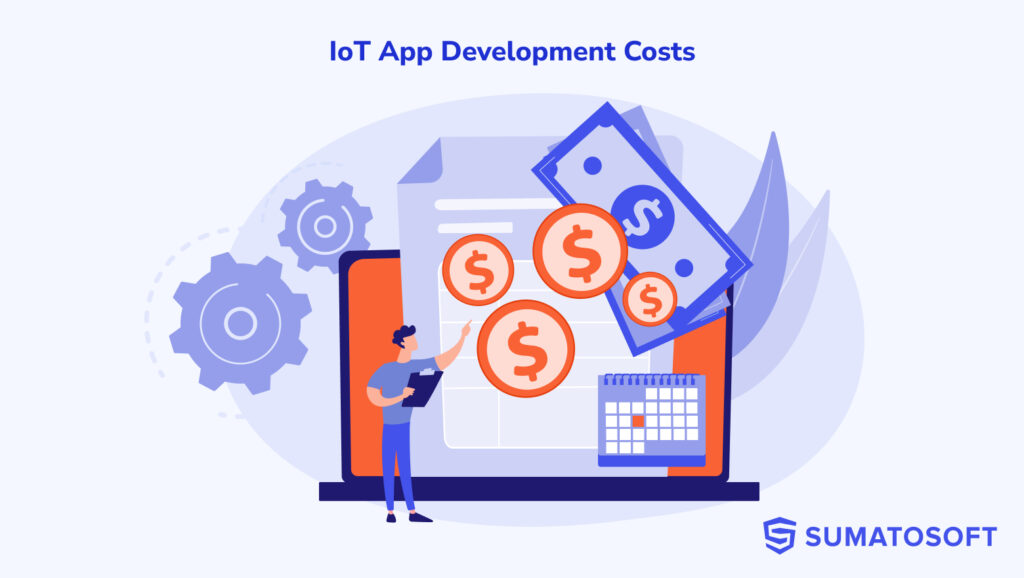
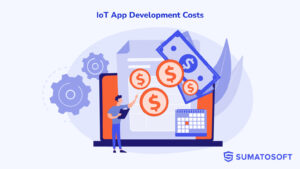
Is it possible to develop an IoT application within $50,000? Yes, it is, but how exactly will this application look, and what will it include?
I’ve led teams of software engineers and developed numerous IoT applications of varying complexity. In this article, I aim to provide an overview of IoT app development costs, explain what you can expect to achieve within different budget ranges, and describe factors that influence the final IoT app development costs.
Let’s break it down!
The State of IoT
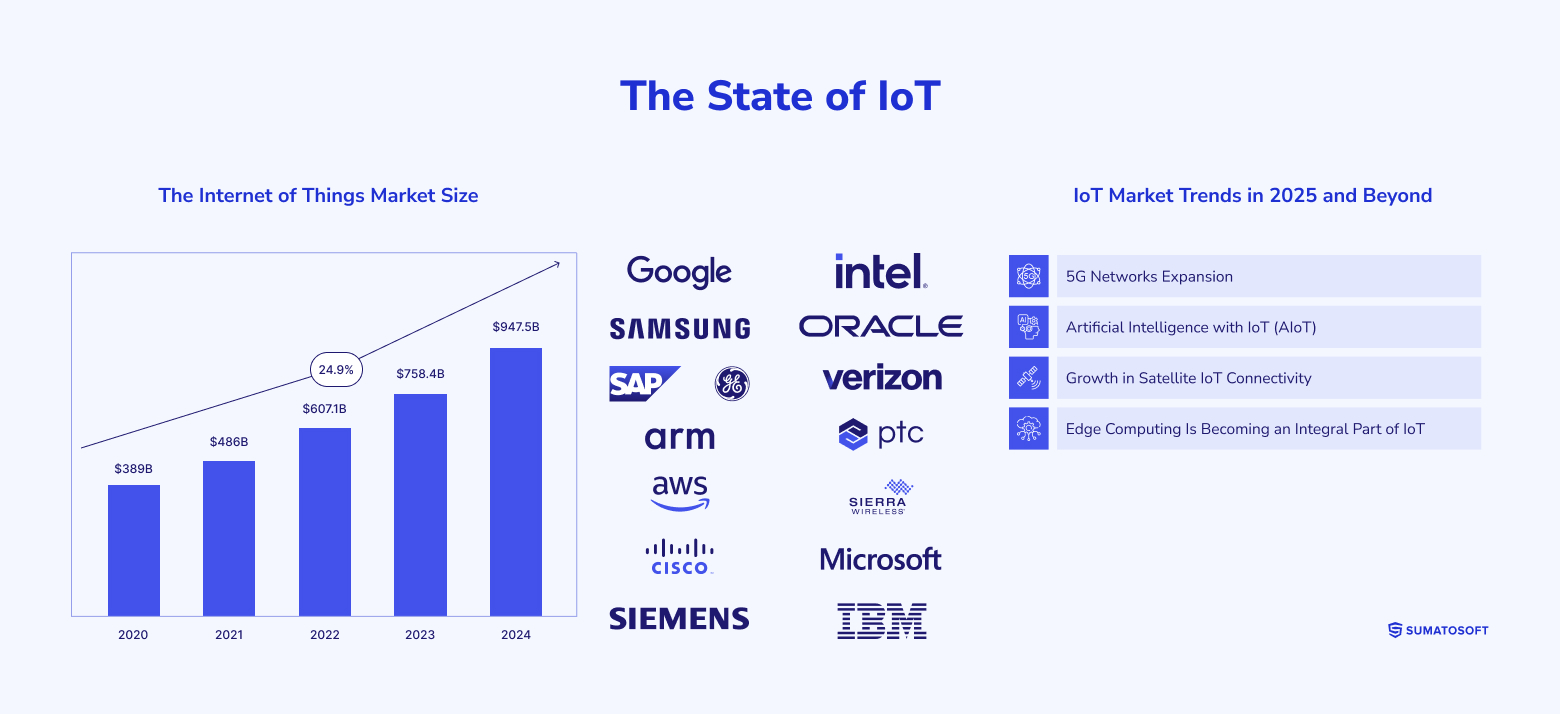
First, let’s highlight the current state of affairs.
The Internet of Things (IoT) market has grown significantly, from $389 billion in 2020 to approximately $947.5 billion in 2024.
This growth is driven by investments from major tech companies like Amazon Web Services (AWS), Microsoft, Cisco, Siemens, IBM, and others. These companies develop IoT platforms, deliver end-to-end solutions, manufacture new gadgets, invent connectivity technologies, and broadly support IoT development. We can expect a significant impact of the Internet of Things on both businesses and economies.
IoT Market Trends in 2025 and Beyond
There are several noticeable trends in this market:
5G Networks Expansion
The global rollout of 5G networks grew from approximately 236 million 5G connections globally in 2020 to 1.6 billion connections in 2024, providing the high-speed, low-latency connectivity essential for advanced IoT applications.
Why it matters: More reliable and efficient communication between IoT devices, which especially matters in sectors like automotive, smart cities, and industrial automation.
Artificial Intelligence with IoT (AIoT)
Back in the late 2010s, the term “Artificial Intelligence of Things” (AIoT) emerged, reflecting the trend of integrating Artificial Intelligence (AI) with the Internet of Things (IoT). In 2018, KPMG published the study Rethinking the Value Chain about the future of AI, which contributed to the discourse around AIoT.
Today, we see companies like Bosch investing heavily in AIoT through initiatives like the Bosch Connected World event and its IoT platform leveraging AI. Siemens has incorporated AI into its IoT ecosystem, MindSphere. Meanwhile, Microsoft’s Azure IoT suite integrates with Azure AI to enable powerful data processing and analytics. This trend is also one of the latest trends in IoT development.
Why it matters: The current traction around AI facilitates IoT development through its integration and investments from major market players and other investors.
Growth in Satellite IoT Connectivity
Satellite connectivity has gained momentum, offering solutions for remote and underserved areas. Companies have launched initiatives to provide global IoT coverage, enabling applications in maritime, agriculture, and environmental monitoring where traditional networks are unavailable.
Several notable companies driving global connectivity include SpaceX with its Swarm Technologies, Satelio with its 5G Narrowband IoT Network, Inmarsat with the ELERA network, and Iridium Communications with its NEXT constellation of 66 satellites—and these are just a few.
Why it matters: Satellite IoT extends the reach of IoT applications to remote and underserved areas, encouraging more companies to invest in IoT solutions.
Edge Computing Is Becoming an Integral Part of IoT
Edge computing enables data processing closer to the source, reducing latency and bandwidth usage, enabling real-time response, and supporting applications that require immediate data analysis, such as industrial automation and autonomous systems.
This trend is evident in several ways:
- According to Statista, The global edge computing market was valued at $4.68 billion in 2020 and has reached $16.45 billion in 2023, driven primarily by IoT adoption.
- According to McKinsey’s research on the Internet of Things opportunities, the existing benefits from operations optimization in manufacturing remain significant drivers of edge computing with IoT.
- Edge Computing News held a survey in 2023 and revealed that 64% of organizations are deploying IoT solutions with edge computing capabilities.
- Gartner predicts that by 2025, 75% of enterprise-generated data will be created and processed at the edge, moving away from centralized data centers.
Why it matters: All IoT systems historically faced limitations that halted their development. These include the need for real-time decision-making, the ability to operate in extreme environments without internet connectivity, and limited power in edge devices. Active investments in IoT are enabling providers to overcome these challenges.
Don’t Confuse: Difference Between IoT Ecosystem, Solution, Platform, and Application
I decided to include this section because various sources on the Internet often use these terms interchangeably when they are not. We won’t spend long on this topic, but it’s a necessary time investment.
IoT Ecosystem
This is the broadest term here. It encompasses everything that enables IoT solutions to function: end-user applications, devices, connectivity protocols, cloud infrastructure, edge computing devices, and more. This term is typically applied to large and complex projects like smart cities, industrial IoT, or smart agriculture.
IoT Solution
This implies a specific implementation of IoT technology to solve a particular business problem. It’s the most relevant term for our topic because businesses often seek IoT solutions to address their needs.
It’s necessary to notice, that an IoT solution can also be an IoT ecosystem – both terms reflect the same concept on different scales. For example, a smart home can be called an IoT solution, while a smart city project is more appropriately described as an IoT ecosystem.
IoT Platform
This serves as the infrastructure that connects devices, manages data flow, and provides tools for building and deploying IoT solutions. Major tech companies like AWS, Microsoft (Azure IoT), and Google Cloud offer IoT platforms. Typically, there’s no need to develop an IoT platform from scratch; instead, the existing IoT platform is integrated into an IoT solution.
IoT Application
This is the user-facing part of the IoT ecosystem. It’s usually a mobile or web application that enables end-users to interact with devices and data. IoT applications provide features like data visualization through dashboards and charts, interfaces for device monitoring, real-time alerts, and other functionalities that allow users to benefit from the IoT ecosystem.
A brief comparison table:
| What is | Who uses | |
|---|---|---|
| IoT Ecosystem | Encompasses the entire IoT environment, connected devices, platforms, applications, and data storage. | Large-scale organizations or industries implementing complex, interconnected IoT systems. |
| IoT Solution | An IoT implementation that addresses a particular business need or problem. | Businesses to get benefits or a competitive advantage. |
| IoT Platform | The underlying structure for IoT solutions for device management, data processing, and connectivity. | Developers and IT teams to build an IoT solution. |
| IoT Application | A user-friendly tool that allows users to interact with the IoT ecosystem. | End-user to gain insights and control devices. |
Let’s summarize:
- Complex projects like a smart city with multiple interconnected small IoT networks are called IoT ecosystems.
- When a business wants to benefit from IoT, it seeks to develop an IoT solution.
- When developers want to develop an IoT infrastructure, they use existing IoT platforms.
- End-users get info from IoT devices and interact with them through IoT applications.
This differentiation is very important. Let’s move on.
Businesses typically need an IoT solution – not the IoT platform, application, or ecosystem.
Factors That Influence The IoT Development Costs
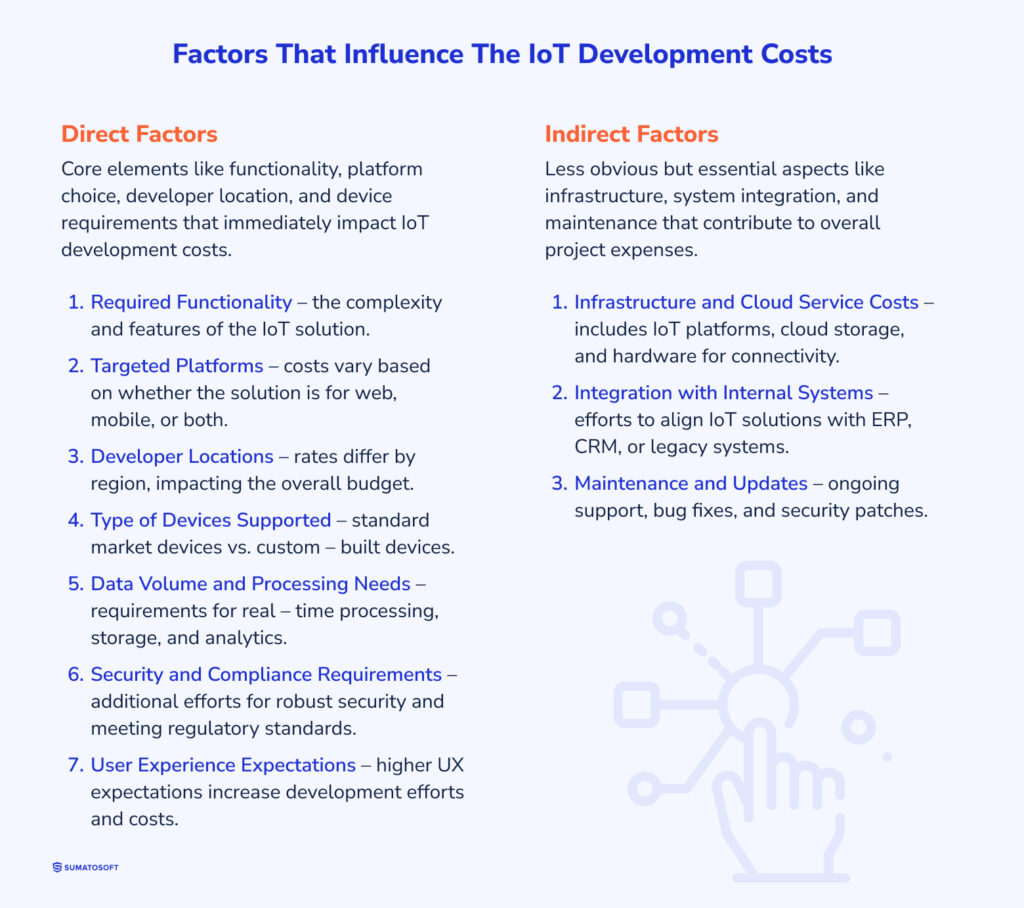
This is the key question: what affects IoT development costs?
First, I’ll discuss the factors that influence IoT solution development costs since that’s likely what you’re here for.
Second, to simplify things, I’ve split the factors into two groups:
Direct costs – these are essential and immediately impactful factors that directly influence development costs. They primarily relate to the project’s technical specifications and the developers’ expertise. Examples of direct costs include required functionality, targeted platforms (web or mobile), developer locations, and more.
Indirect costs – these are less obvious costs that still play an integral role in the total expenses. Examples of indirect costs include infrastructure costs (with the IoT platform as part of it), hosting, and integrations with internal systems.
Some articles refer to these as the “secret” or “hidden” costs of IoT app development. However, the reality is less dramatic – these are simply non-obvious expenses that businesses often overlook, while development companies may downplay them to make initial project estimates appear lower.
Direct Factors
First, let’s overview these costs. There are 7 direct factors:
Factor 1: Required Functionality
Also referred to as “project scope and complexity,” this factor relates to the expected features and capabilities of the final IoT solution. The more complex and feature-rich the application, the higher the development cost.
If you ask a company to estimate the costs of an IoT project, the final estimation will likely detail a set of functions for your IoT solution.
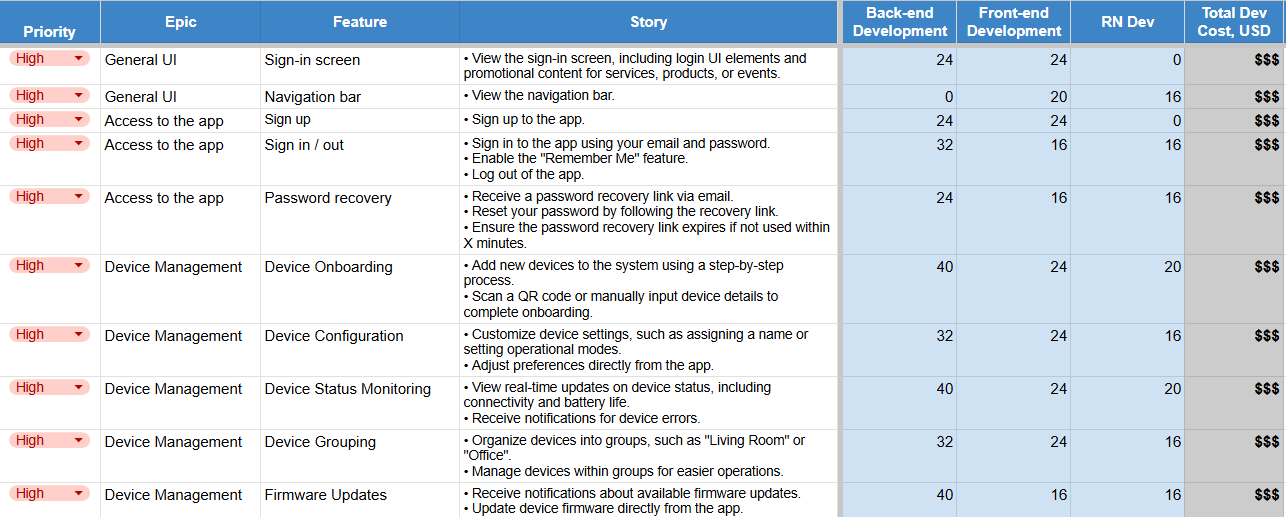
Factor 2: Targeted Platforms (Web or Mobile)
The platform choice is another direct factor that could theoretically double the budget if the app targets multiple platforms.
A web platform generally requires fewer resources, as it involves a single codebase and is accessible on any device via a browser. In contrast, a mobile platform may involve either native development (iOS and Android separately) or cross-platform frameworks like Flutter or React Native.
Native development offers the best performance and access to device-specific features, but it doubles the effort since each platform requires its own codebase. Cross-platform development reduces costs by using a single codebase, though it may not fully meet the requirements of applications needing high-performance or specialized hardware access.
If the project includes both web and mobile platforms, costs increase due to the need to build and maintain separate or complementary solutions for each platform.
Factor 3: Developer Locations
The geographic location of the development team significantly influences the hourly development rate, which directly affects the final development costs. For a more detailed analysis, check out our article on software outsourcing rates.
There are several geographical clusters:
| Region | Hourly Rate Range, $ |
|---|---|
| North America | $71 – $95 |
| Central Europe | $42 – $74 |
| Eastern Europe | $27 – $51 |
| South Asia | $22 – $44 |
| Southeast Asia | $24 – $35 |
| India | $6 – $12 |
| Latin America | $35 – $60 |
Factor 4: Type of Devices Supported
There are two key considerations here:
Standard Market Devices
These are pre-built devices, such as smart bulbs, thermostats, or fitness trackers, that are already available in the market. Integrating these devices into an IoT solution is generally less expensive since the hardware is readily available, tested, and documented. Development efforts focus primarily on connectivity, data handling, and integration.
Custom Devices
If your project requires custom-built IoT devices tailored to specific use cases (e.g., industrial sensors or proprietary hardware), development costs increase. Custom devices demand more integration effort, extensive testing, debugging, and often firmware updates, which result in corresponding software updates.
One less obvious factor: the number of identical devices doesn’t affect software development costs.
Factor 5: Data Volume and Processing Needs
The amount of data your IoT solution generates and processes significantly impacts development costs. Higher data volumes require robust infrastructure, efficient processing systems, and advanced analytics, which can drive up costs. Key considerations include:
- real-time processing;
- storage requirements;
- data analysis and visualization;
- bandwidth and connectivity.
IoT projects generating minimal data, such as basic monitoring systems, are less expensive than those handling vast amounts of data with real-time requirements and complex analytics.
Factor 6: Security and Compliance Requirements
Applications dealing with sensitive data or operating in regulated industries incur additional costs as robust security measures and compliance efforts are implemented.
Examples of security measures include implementing data encryption to secure information during transmission, using secure communication protocols to prevent breaches, and setting up user authentication and access control mechanisms to limit unauthorized access.
Additionally, projects often need to comply with regulations like GDPR for data protection in the EU or HIPAA for healthcare IoT development in the US. Meeting these standards requires additional development time, documentation, and testing, which increases costs. Regular security audits and vulnerability testing are also necessary to maintain system integrity over time.
Factor 7: User Experience Expectations
The more polished, intuitive, and feature-rich the UX, the higher the development cost.
Meeting high UX expectations often involves designing visually appealing interfaces, creating seamless navigation flows, and ensuring the application is responsive across devices.
For IoT, this includes real-time data visualization through dashboards and charts, as well as interactive controls for managing connected devices. Customizing the experience – such as tailoring the interface to specific user roles or integrating accessibility features – adds complexity and costs. Custom interfaces, in turn, imply extra testing and refining, which drives costs even further.
Indirect or Hidden Factors
While direct factors often dominate budget discussions for IoT development, there are some indirect or hidden costs that might become an unpleasant surprise. I grouped them into 3 categories:
- infrastructure costs;
- integration with internal systems;
- maintenance and future updates.
Factor 1: Infrastructure and Cloud Service Costs
This includes both software and hardware expenses that are often overlooked.
Infrastructure costs encompass subscriptions to IoT platforms like AWS IoT Core or Azure IoT, as well as cloud services like AWS S3 or Azure Blob Storage for data storage and processing. Hosting expenses, the purchase and configuration of gateways to connect IoT devices to the cloud (if needed), and networking equipment such as Wi-Fi routers, cellular modules, and LoRaWAN base stations also fall into this category.
Factor 2: Integration with Internal Systems
Integrating IoT solutions with existing internal systems, such as ERP, CRM, or proprietary databases.
This often involves developing or customizing APIs, building middleware, and mapping IoT data formats to align with internal systems. Costs increase with the complexity of the existing infrastructure, especially when dealing with legacy systems.
Factor 3: Maintenance and Updates
IoT solutions require ongoing maintenance and periodic updates to remain functional and secure.
Maintenance includes regular software updates, bug fixes, and security patches to protect against newly identified vulnerabilities.
IoT Solution Components: Breaking Down
We are close to examining costs in numbers, but there is still some work to be done. We need to understand the components of an IoT solution that developers typically deal with.
Here are seven components with detailed explanations following:
- device or sensors;
- connectivity;
- gateway or cloud connector;
- cloud & API;
- analytics;
- integration with internal systems;
- end-user application.
This structure simplifies further reading but isn’t an officially stated list. For more theoretical information about IoT ecosystem components, check out the article on our blog.
1. Devices or Sensors
Developer role: Limited with few opportunities.
Devices or sensors are electronic gadgets that gather information or perform specific actions.
Software developers can calibrate and configure the device to ensure it is ready for data transmission and reception or provide feedback on device operations and suggest modifications if they have relevant expertise.
2. Connectivity
Developer role: Limited with some opportunities.
Connectivity serves as the communication layer between the device, the network, and the user application. The communication might go through gateways or directly through the Internet.
Software developers can configure connectivity settings for network protocols like Wi-Fi, LTE, Bluetooth, or LPWAN (e.g., LoRa, NB-IoT). They may also optimize data transmission by compressing data, minimizing bandwidth usage, or implementing failover mechanisms. Ensuring secure connections involves using encryption protocols and secure communication channels. There are multiple techniques like bandwidth throttling or transmission scheduling that help to secure communication, but they are beyond the scope of this discussion.
A significant part of the work involves testing the connection and verifying the correctness of incoming and outgoing data. Connectivity can be bidirectional, allowing the device to send and receive data, or unidirectional, sending signals in only one direction.
3. Gateway (or Cloud Connector)
Developer role: Limited with some opportunities.
A gateway or cloud connector is a device that bridges the IoT device with the cloud. Software developers can configure middleware on the gateway to handle data aggregation, local processing, and filtering. They also manage data traffic by implementing protocols like MQTT or AMQP, ensuring reliable communication between edge devices and the cloud. Additionally, developers can implement edge analytics to preprocess data at the gateway level, reducing the load on cloud resources and enabling faster decision-making.
4. Cloud & API
Developer role: Significant, high involvement.
Cloud and API form the infrastructure that stores, processes, and manages IoT data, while APIs enable communication with the infrastructure. Software developers set up the cloud infrastructure and develop API endpoints, which requires significant development effort.
5. Analytics
Developer role: Significant, high involvement.
Analytics tools process data generated by IoT devices. Software developers establish data processing pipelines to clean, organize, and prepare data for analysis. They also configure real-time analytics using third-party providers or internal solutions and use machine learning algorithms for advanced analytics.
6. Integration with Internal Systems
Developer role: Significant, high involvement.
This component serves as the data exchange layer between the cloud and internal systems. Software developers create middleware, handle data mapping and transformation, and develop custom APIs to integrate IoT data with existing internal systems such as ERPs, CRMs, or SCMs.
7. End-User Application
Developer role: Significant, high involvement.
The end-user application is the web or mobile interface that allows users to interact with IoT data and control devices. This is what is typically referred to as the IoT application. Software developers build these applications with real-time data visualization tools like dashboards and charts, as well as other features such as device management modules, notifications, alerts, and customization options.
Let’s summarize all the components in a picture. I will reuse this image when describing cost tiers.
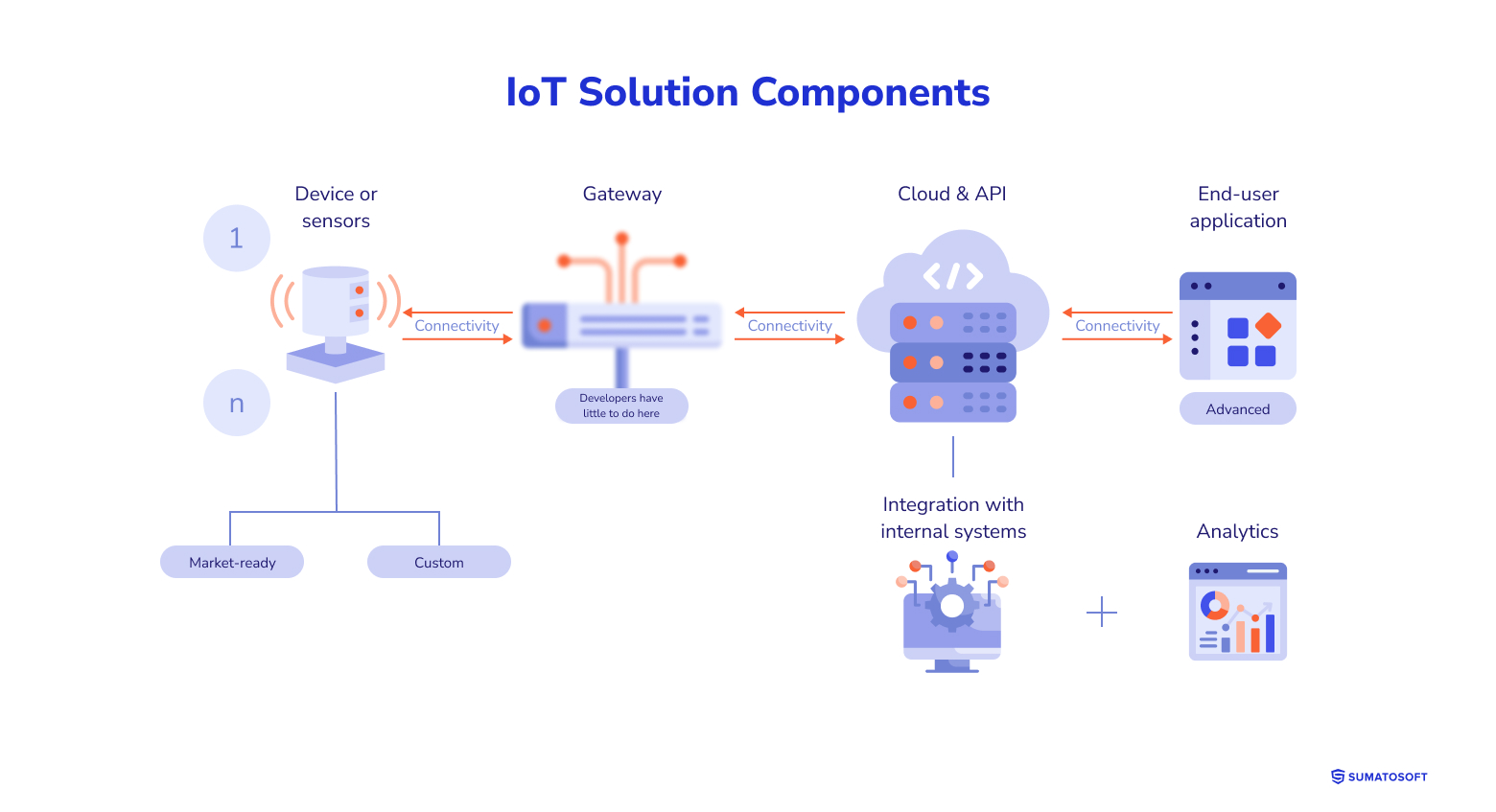
Tiers of IoT Solution Development Costs
It’s time to put everything I’ve described above together. Like a reward in the long adventure journey when the main character needs to overcome obstacles on its road, copes with challenges, faces the fears, so we passed this knowledge journey to this point. Every bit of acquired information will facilitate the understanding of this chapter.
Tier 1: IoT App Under $50,000
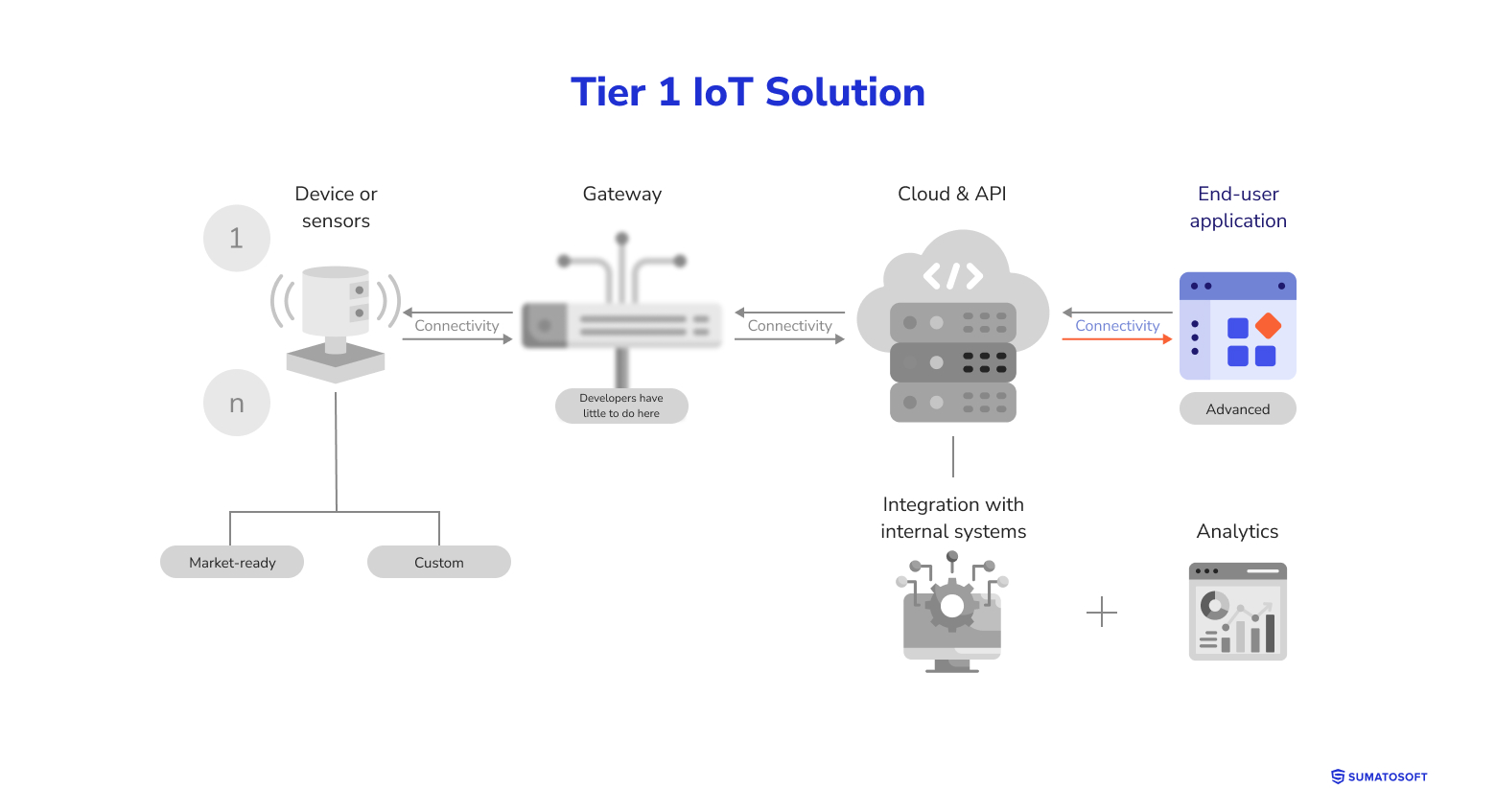
A functional user application with simple data visualization from IoT devices. This assumes that the cloud is fully configured and requires only minor adjustments, the API endpoints are already developed, and the remaining task is to build the user application.
Covered components:
- End-user application (simple) – a basic interface with limited customization, focusing on essential functionality.
- Connectivity (unidirectional) – simple one-way communication from device to app.
Examples:
- Environmental monitoring applications for tracking temperature, humidity, or flooding in offices, homes, or facilities.
- Asset trackers for monitoring the location and status of equipment or vehicles using GPS.
- Wearable health monitoring applications that provide basic health metrics and sync with a mobile app for tracking.
Tier 2: IoT Application From $50,000 to $200,000
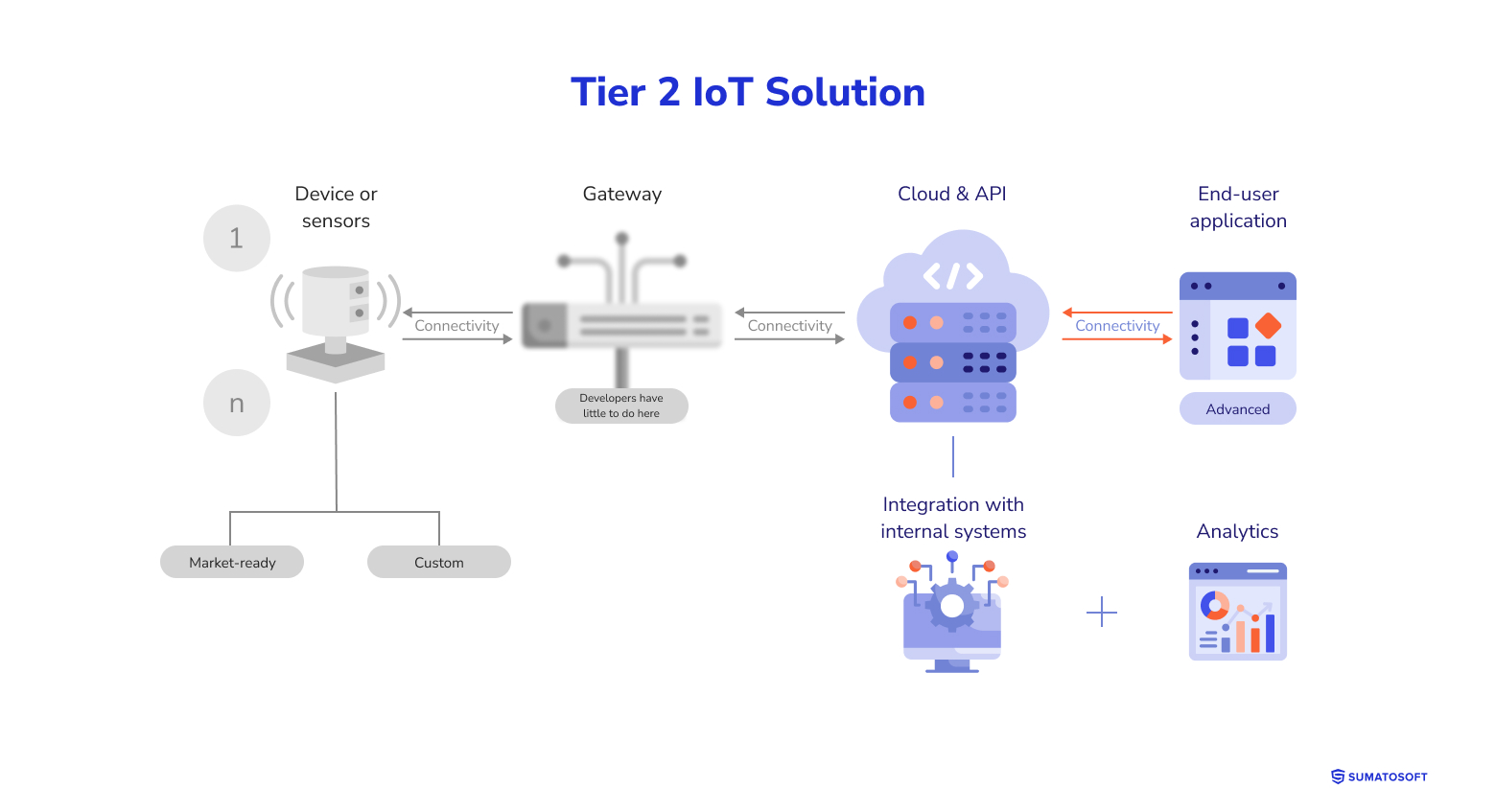
Advanced user applications with complex analytics and the ability to monitor and control devices within the network. Most mid-level IoT solutions fall into this category. This is a typical software development scenario: building all backend API endpoints, configuring the cloud, and managing the necessary integrations and analytics capabilities.
Covered components:
- End-user application (advanced) – more sophisticated application with modern aesthetics, great customization, real-time animation, and more.
- Integration with internal systems – established communication with internal systems like inventory management or ERP.
- Analytics setup – the presence of analytics opportunities in the solution so that users have enough information to make data-driven decisions.
- Cloud & API setup – fully configured cloud storage and developed APIs that allow the app to interact with the device and get info from it.
- Connectivity (bidirectional) – two-way communication between the device and IoT app.
Examples:
- Industrial equipment health monitoring solutions with performance assessment, preventive maintenance, customizable dashboards, and multiple user roles.
- Warehouse inventory monitoring systems that track inventory levels in real-time using IoT sensors, send notifications when stock levels fall below a threshold, and provide insights into space usage and demand.
- Smart home energy management systems that monitor and control energy usage, analyze consumption patterns, and offer remote device management capabilities.
- Smart retail inventory systems for tracking stock levels, generating alerts, and providing analytics.
Tier 3: IoT Solution From $200,000 to $500,000
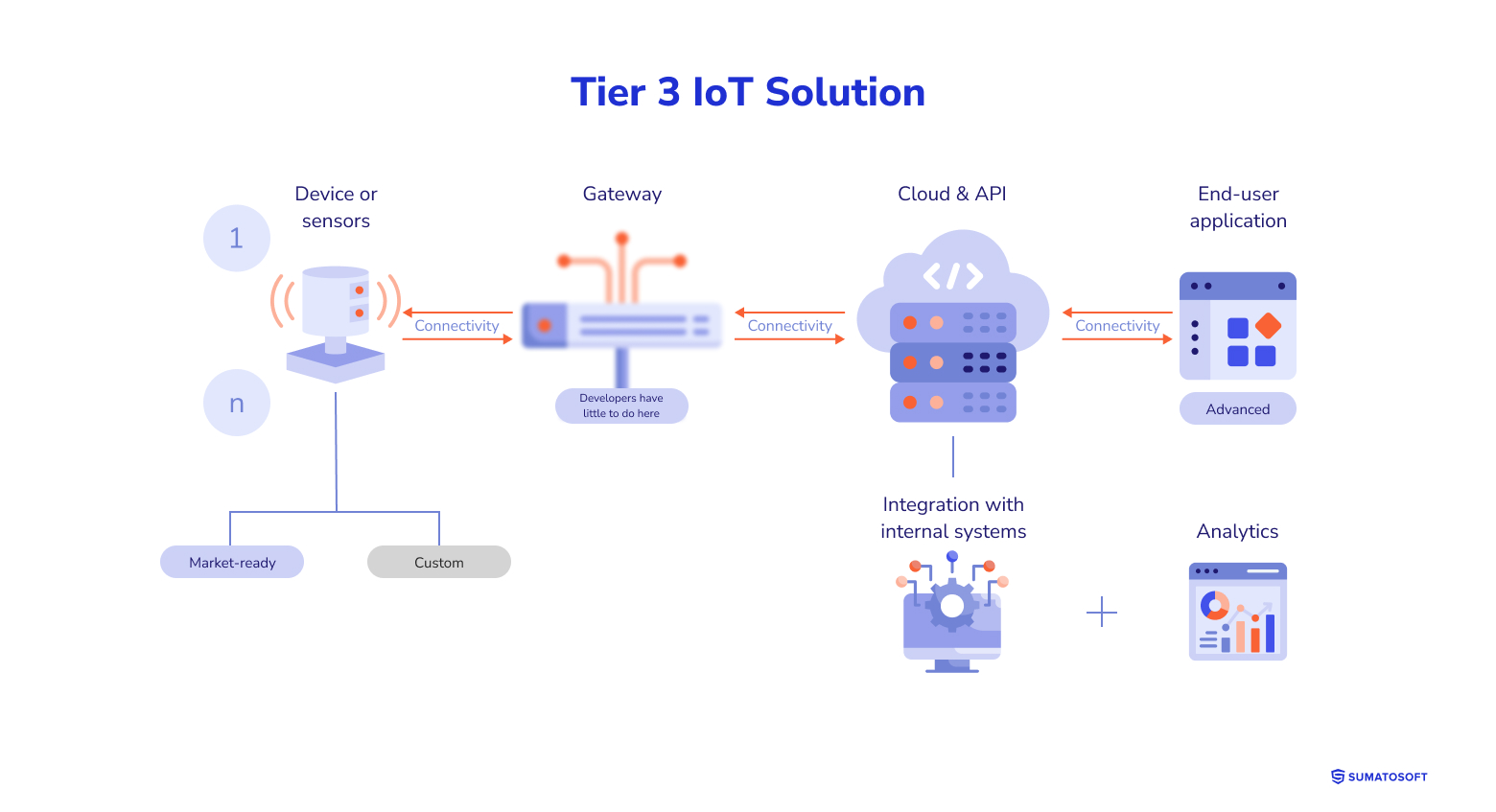
Tier 3 shifts from the term IoT application to IoT solution from the developer’s perspective, as developers also manage IoT device network configuration. This includes assisting in selecting IoT gateways, configuring data flow and exchange, and connecting multiple devices to the network.
This tier involves complex IoT applications with advanced data handling, predictive analytics, and real-time control and monitoring capabilities.
Covered components:
- End-user application – fully featured, customizable interface.
- Integration with internal systems – deep integration with internal systems like inventory management or ERP.
- Analytics setup – advanced analytics with real-time data processing and predictive capabilities.
- Cloud / API setup – comprehensive cloud setup, optimized for scalability and high performance.
- Connectivity (bidirectional) – real-time bidirectional communication.
- Device integration (standard market devices) – integration and calibration of off-the-shelf devices such as common sensors or consumer-grade IoT hardware.
- Gateway / cloud connector setup – configures IoT gateways or cloud connectors for handling larger volumes of data and edge processing if needed.
Examples:
- An IoT system with multiple sensors in hotels for tracking trash levels.
- An IoT solution that monitors vehicle locations, fuel usage, and maintenance needs, providing a centralized dashboard for fleet managers.
- An agriculture IoT solution that tracks soil moisture, temperature, and other environmental conditions.
Tier 4: IoT Ecosystem, $500,000+

These are enterprise and industrial-grade IoT solutions with unique requirements, environments, and existing infrastructure. These solutions include all components from the previous tiers but on a much larger scale. IoT ecosystems, such as IoT for smart cities with systems for lighting, traffic management, public transport, and more, fall into this category.
Covered components:
- End-user application (advanced).
- Integration with internal systems – integration with multiple internal systems and between different IoT networks.
- Analytics setup – advanced analytics and machine learning capabilities for predictive insights, anomaly detection, and real-time analysis.
- Cloud / API setup – enterprise-grade cloud architecture with high scalability and advanced security.
- Connectivity (bidirectional) – bidirectional communication with optimized protocols for low-latency, high-reliability interactions.
- Device integration (custom devices) – integration and calibration of custom-built devices developed specifically for the project.
- Gateway / cloud connector setup – sophisticated gateway configuration to handle high data volumes, edge processing, and multi-protocol support.
Examples:
- Smart building management systems for HVAC, lighting, security, occupancy, anomaly detection, and energy management.
- Connected healthcare platforms integrating data from multiple devices to support real-time monitoring, predictive analytics, and telemedicine.
- Smart grid management systems that oversee energy distribution and consumption across regions, incorporating predictive analytics for load balancing and fault detection.
- Advanced agriculture systems that monitor soil conditions, weather, and crop health, offering automated irrigation and fertilization recommendations.
- Smart city ecosystems.
Tier Comparison Table
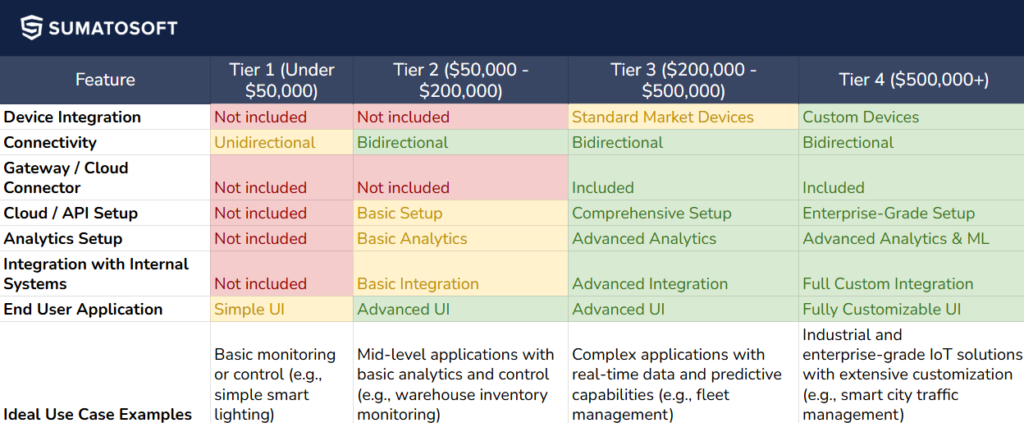
How SumatoSoft Develops IoT Projects
SumatoSoft has been delivering IoT software development services since 2012, delivering custom enterprise software and developing MVPs for startups to gain a competitive advantage and improve their efficiency, effectiveness, and profit through business digitalization.
We deliver IoT applications and systems of any complexity, including a fitness tracking system, a smart fridge sensors system, a platform for farm animal health monitoring, and warehouse automation, and these are just a few.
The SumatoSoft team has built 250 custom software solutions for 27 countries for 11 industries. After more than 12 years on the market, the company became a reliable technical partner to its Clients, demonstrating a 98% Client satisfaction rate with the quality of services they provide.
Contact us to get a free quote for your project.
Afterwards
Now, onto the final part: I believe we’re ready to formulate the correct questions and provide the answers.
How Much Does IoT App Development Cost?
Up to $50,000 could be spent developing a simple, functional user application (Tier 1) with basic data visualization. These applications rely on existing backend infrastructure and require only minor adjustments.
For more advanced IoT applications (Tier 2) that include backend development, cloud configuration, analytics setup, and bidirectional connectivity, costs can range from $50,000 to $200,000.
How Much Does IoT Platform Development Cost?
Developing an IoT platform is a complex and expensive endeavor, often costing millions of dollars. This is because IoT platforms are designed as tools for other businesses to use, requiring robust scalability, advanced features, and support for diverse use cases. Most businesses don’t need to develop a platform from scratch and instead focus on integrating existing platforms like AWS IoT or Azure IoT.
How Much Does IoT Solution Development Cost?
For IoT solutions (Tier 3), which include advanced data handling, predictive analytics, and device network configuration, costs typically range from $200,000 to $500,000. This tier involves comprehensive development, including IoT gateway setup, device integration, and a fully featured end-user application.
How Much Does IoT Ecosystem Development Cost?
For enterprise-grade IoT ecosystems (Tier 4), costs start at $500,000 and can go much higher. These solutions involve integrating multiple IoT networks, custom device development, advanced analytics with machine learning, and highly scalable cloud infrastructure. Examples include smart city systems or connected healthcare platforms.
Let’s start
If you have any questions, email us info@sumatosoft.com

